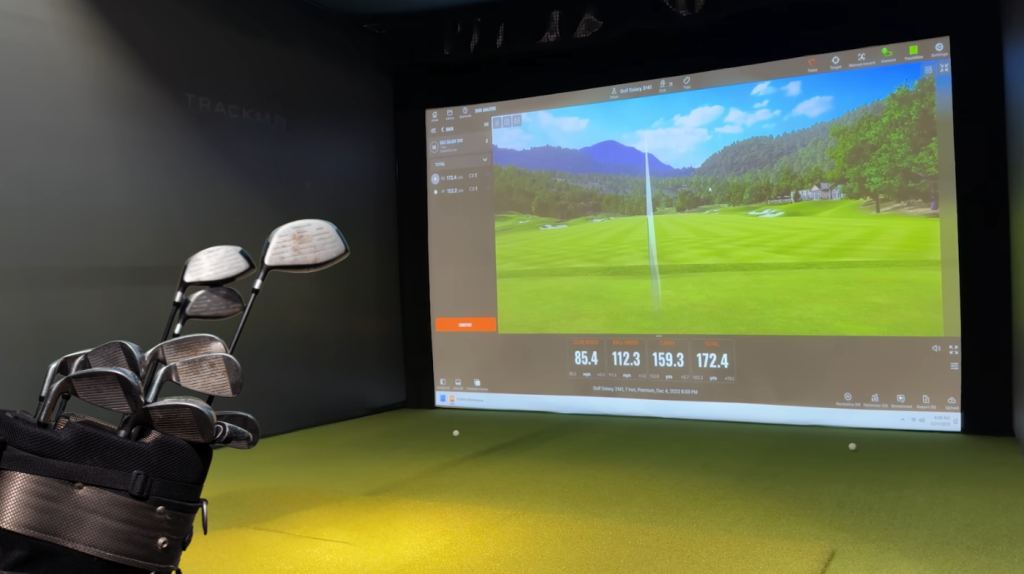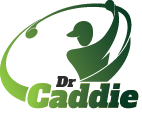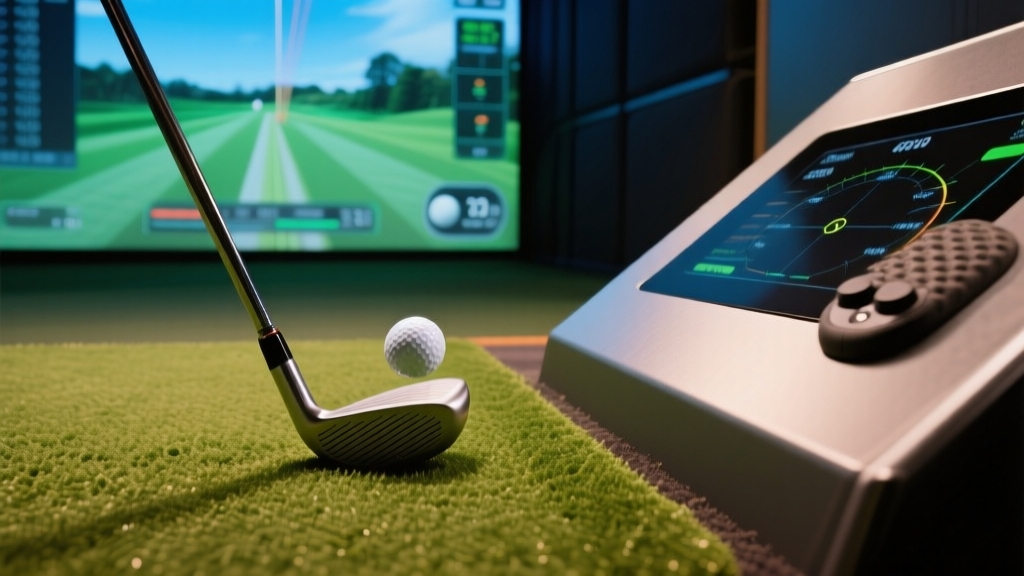You can expect modern golf simulators to deliver shot data with 1-3% accuracy, reliably capturing metrics like ball speed, launch angle, spin, and clubhead speed.
High-end models use advanced cameras and radar for precise tracking, but proper calibration and controlled environments are essential to maintain data reliability.
While simulators offer consistent indoor conditions, they can’t fully replicate outdoor variables like wind or terrain. If you want to understand how these factors impact your game, there’s more to explore.
- Key Takeaways
- Accuracy Levels Achieved by Modern Golf Simulators
- Influence of Hardware and Tracking Technologies
- Importance of Calibration and Setup for Precision
- Key Data Parameters and Their Measurement Accuracy
- Limitations of Simulators Compared to Outdoor Golf
- Utilizing Simulators for Club Fitting and Training
- When Setup Is Right, Indoor Golf Practice Feels Like the Real Course
Key Takeaways
- Modern golf simulators achieve shot data accuracy within 1-3%, with high-end models exceeding 95% precision.
- They accurately measure ball speed, launch angle, spin, and club path essential for performance analysis.
- Proper calibration and controlled indoor environments are critical for maintaining reliable and consistent data.
- Simulators provide real-time feedback, enabling quick swing adjustments and skill improvement.
- While highly accurate, simulators lack environmental factors like wind and terrain, limiting outdoor realism.
Accuracy Levels Achieved by Modern Golf Simulators
Although no simulator can perfectly replicate every nuance of outdoor play, modern golf simulators achieve impressive accuracy levels. They typically match real course shot data within a 1-3% variance.
Some models report match rates around 2.19%, with high-end units surpassing 95% accuracy in measuring ball flight, distance, spin, and club data. These simulators precisely track shot parameters like ball speed, launch angle, spin rate, and club path to replicate real-world dynamics. The choice of equipment, such as using a milled putter, can influence the simulation’s feedback on feel and control.
Camera-based systems excel indoors by capturing spin rates more accurately than radar. The software processes these inputs to simulate realistic trajectories, including draws and fades. Additionally, many simulators use Precision Tracking Technology combining high-speed cameras and sensors to provide real-time understanding of shot dynamics.
While environmental factors such as wind and terrain introduce unavoidable variations, the data precision you get from these simulators offers reliable feedback for improving your game and optimizing equipment choices.
Influence of Hardware and Tracking Technologies
Because hardware and tracking technologies form the foundation of golf simulator accuracy, understanding their roles is essential. You’ll find launch monitors—using high-speed cameras, radar, or stereo vision—central to tracking critical data like clubhead speed, ball speed, launch angle, and spin rate.
Features such as hyper speed cameras and multiple tracking metrics deliver highly precise club and ball data, making the simulation experience more realistic. The choice of hardware also affects power consumption and performance, similar to how different voltage levels impact golf cart capabilities.
Top models such as Uneekor and Foresight Sports employ machine vision and 3D ball position tracking, enhancing precision. Optical systems like QED’s OPTIX reduce performance variance to 2.19%, surpassing typical 5% benchmarks.
However, radar units struggle with slow shots indoors and need ample space. Lighting and environment also affect sensor fidelity: even, soft lighting minimizes errors, while shadows and reflections degrade accuracy. Ensuring optimal setup conditions parallels the importance of battery type and charger compatibility in maintaining reliable operation.
Importance of Calibration and Setup for Precision
When you calibrate your golf simulator accurately, you guarantee that critical metrics like clubhead speed, ball spin, and launch angle are recorded with precision. This directly impacts the reliability of your performance data.
Calibration aligns sensors and cameras to prevent measurement errors. It also ensures software algorithms correctly interpret raw data. Proper calibration also enables consistent swing analysis, helping track your progress reliably over time.
Just as securing a golf cart properly ensures safety during transit, precise calibration ensures safety and accuracy in data capture. Without proper setup, your swing assessments and shot simulations risk distortion.
To optimize precision, you should:
- Align sensors precisely relative to the hitting area and ball position.
- Adjust software settings to compensate for environmental factors and sensor latency.
- Maintain consistent room dimensions, lighting, and sensor angles for stable data capture. Similar to how sway bars stabilize trailers during transport, consistent environmental control stabilizes the quality of your simulation data.
- Regularly recalibrate to sustain accuracy across sessions and long-term tracking.
Key Data Parameters and Their Measurement Accuracy
Understanding the accuracy of key data parameters is essential for trusting your golf simulator’s feedback and improving your game.
Core metrics like ball speed and launch angle often achieve 1-3% accuracy, closely mirroring real-world conditions. Using adhesive-backed material in grip installations can similarly enhance real-world performance by ensuring consistency.
Spin rate accuracy varies significantly. Radar-based indoor estimates can reduce precision, while camera-based systems actively track spin for better results. Clubhead speed and swing path depend heavily on sensor quality. Despite slight variability, they provide valuable real-time insights that enhance your practice sessions.
A well-calibrated system with high-quality sensors is crucial to minimize errors and ensure the data closely reflects real-life golf mechanics.
| Parameter | Typical Accuracy |
|---|---|
| Ball Speed | ±1-3% |
| Launch Angle | ±1-3% |
| Spin Rate | Variable; better with cameras |
| Clubhead Speed | ±2-4% |
| Club Path | Slight variability |
This data precision supports effective practice, fitting, and performance analysis.
Limitations of Simulators Compared to Outdoor Golf

Although golf simulators provide valuable data and convenience, they can’t fully replicate the complexities of outdoor golf. You’ll notice several limitations that affect realism and training effectiveness.
Environmental factors like wind, variable lighting, and terrain nuances are absent. This impacts ball behavior and shot strategy, making the experience less authentic. Simulators generally achieve accuracy within a 1-3% margin, but this precision is primarily observed in full-swing shots rather than short game play. Additionally, the lack of tactile feedback fails to simulate the grip pressure nuances important for shot control.
Course hazards such as bunkers, thick rough, and water hazards lack realistic physical and psychological challenges. This reduces the mental aspect of course management. Simulators also miss tactile feedback from different surfaces. Additionally, they don’t capture immersive elements like crowd noise or natural distractions.
Accuracy can vary due to calibration, hardware precision, and algorithm limitations. These issues sometimes cause yardage discrepancies. Understanding these constraints helps you set realistic expectations. It’s important to complement simulator practice with outdoor rounds for a well-rounded game.
Utilizing Simulators for Club Fitting and Training
Golf simulators offer more than just convenience—they provide highly precise data that can significantly enhance club fitting and training. Using advanced radar and camera technologies, you get over 90% accuracy in key metrics like ball speed and spin rate, essential for customized club fitting. Additionally, the materials & construction of golf equipment can be better analyzed when paired with simulator data, improving overall performance insights.
Simulators also deliver immediate feedback on swing mechanics, enabling rapid skill improvement through real-time adjustments. This instant insight helps golfers make necessary corrections on the spot, accelerating their development.
The repeatability of indoor sessions ensures consistent data, boosting fitting precision and training effectiveness. Unlike outdoor conditions that can vary, simulators provide a controlled environment for reliable results every time. Many professional fitters trust Trackman technology for its unmatched accuracy in capturing comprehensive swing details.
Key aspects such as clubhead speed, spin rate, and launch angle are measured with high accuracy. This precise data allows for tailored club choices, improved shot control, and optimized ball trajectory for better distance.
Real-time feedback further accelerates skill refinement, while consistent conditions guarantee dependable fitting and training outcomes, making simulators an invaluable tool for golfers of all levels.
| Aspect | Benefit |
|---|---|
| Clubhead Speed | Accurate measurement for tailored club choice |
| Spin Rate | Precise data improves shot control adjustments |
| Launch Angle | Optimizes trajectory for better distance |
| Real-Time Feedback | Accelerates skill refinement |
| Consistent Conditions | Ensures reliable fitting and training outcomes |
Frequently Asked Questions
Can Golf Simulators Be Used Effectively for Indoor Golf Tournaments?
Yes, you can use golf simulators effectively for indoor tournaments. They offer over 90% accuracy in key metrics like launch angle and ball speed, ensuring fair competition.
You’ll benefit from controlled conditions that eliminate weather variables, enabling consistent play. Just make sure all simulators are calibrated uniformly and the space meets size requirements.
Keep in mind, some short game shots and uneven lies aren’t perfectly replicated, so focus your tournament on full shots and driving accuracy.
How Do Golf Simulators Handle Different Types of Golf Balls?
Imagine your golf ball is like a different breed of racehorse—some simulators recognize certain “breeds” better than others.
Radar-based systems like the Flightscope Mevo+ pick up standard balls like Pro V1 more accurately, while camera-based systems depend on visible markings to capture spin. Using specialized balls can tweak spin accuracy by about 6%, but may reduce distance precision.
Are Golf Simulators Compatible With All Golf Club Brands?
Yes, golf simulators generally work with all golf club brands, so you can use your own clubs without worry. Compatibility mainly hinges on the simulator’s software and hardware rather than the club brand itself.
For example, launch monitors like SkyTrak+ and ProTee VX support various third-party software, ensuring seamless integration. Just make sure your simulator’s system supports the software you prefer, and you’ll get a smooth, versatile experience regardless of the clubs you bring.
What Is the Typical Maintenance Required for Golf Simulator Equipment?
You’ll need to clean optical sensors and lenses gently, wipe simulator screens regularly, and dust projector vents to keep image quality sharp.
Software updates and hardware calibrations are essential for accuracy, so stay on top of manufacturer maintenance schedules.
Inspect cables and replace worn mats or bulbs to prevent failures.
Regularly check your frame and screen tension to avoid damage, ensuring your simulator runs smoothly and delivers consistent performance over time.
Can Golf Simulators Track and Improve Putting Accuracy?
Yes, golf simulators can track and improve your putting accuracy. They measure key metrics like ball speed, roll distance, face angle, and club path, giving you precise feedback.
You’ll see detailed data on green conditions, speed control, and slope effects, helping you adjust your technique effectively. With realistic simulations and customizable drills, you can practice consistently, refine your stroke, and enhance your overall putting performance efficiently.
When Setup Is Right, Indoor Golf Practice Feels Like the Real Course
You might be surprised how accurate modern golf simulators can be, often matching outdoor conditions within just a few percentage points. But don’t forget, their precision hinges on quality hardware, proper calibration, and the specific data parameters they track.
While simulators can’t fully replicate every nuance of outdoor play, their reliability makes them invaluable for club fitting and training. So, when technology and setup align, your indoor swing insights can truly mirror the real course.

